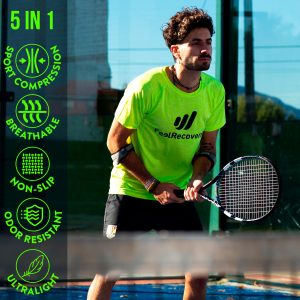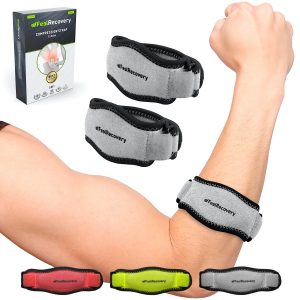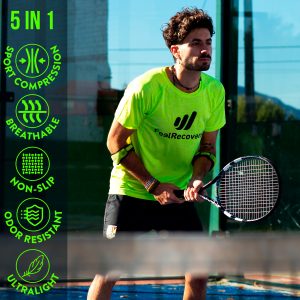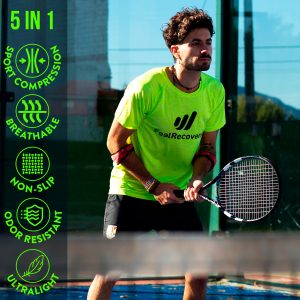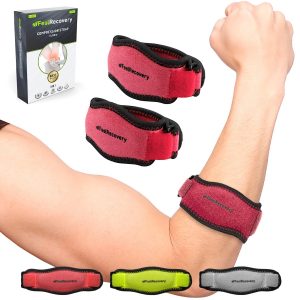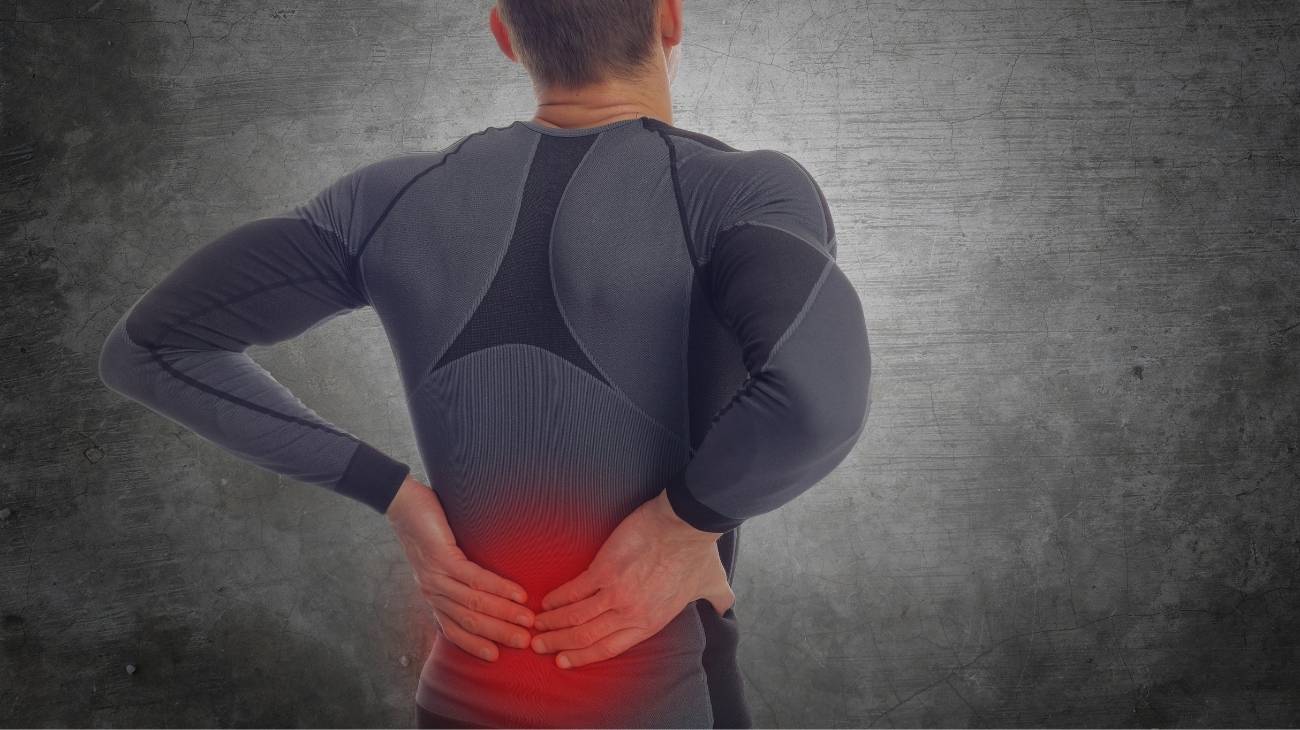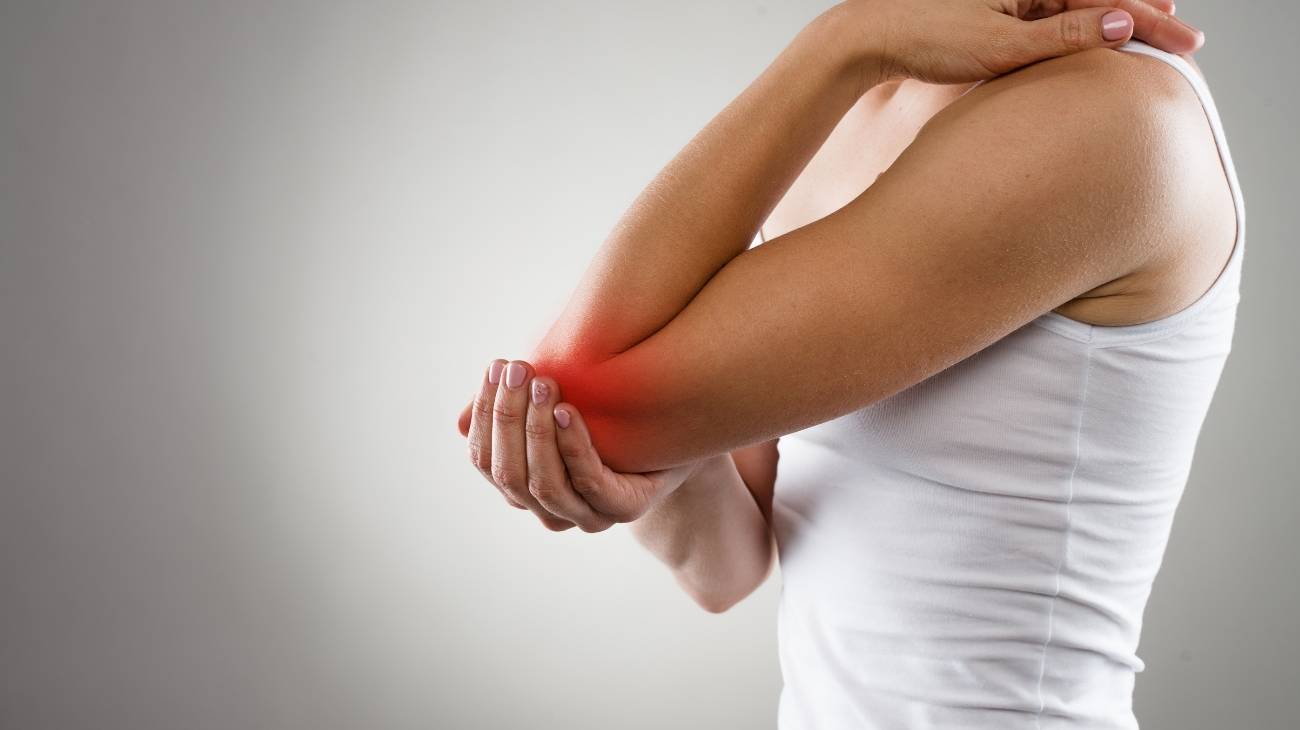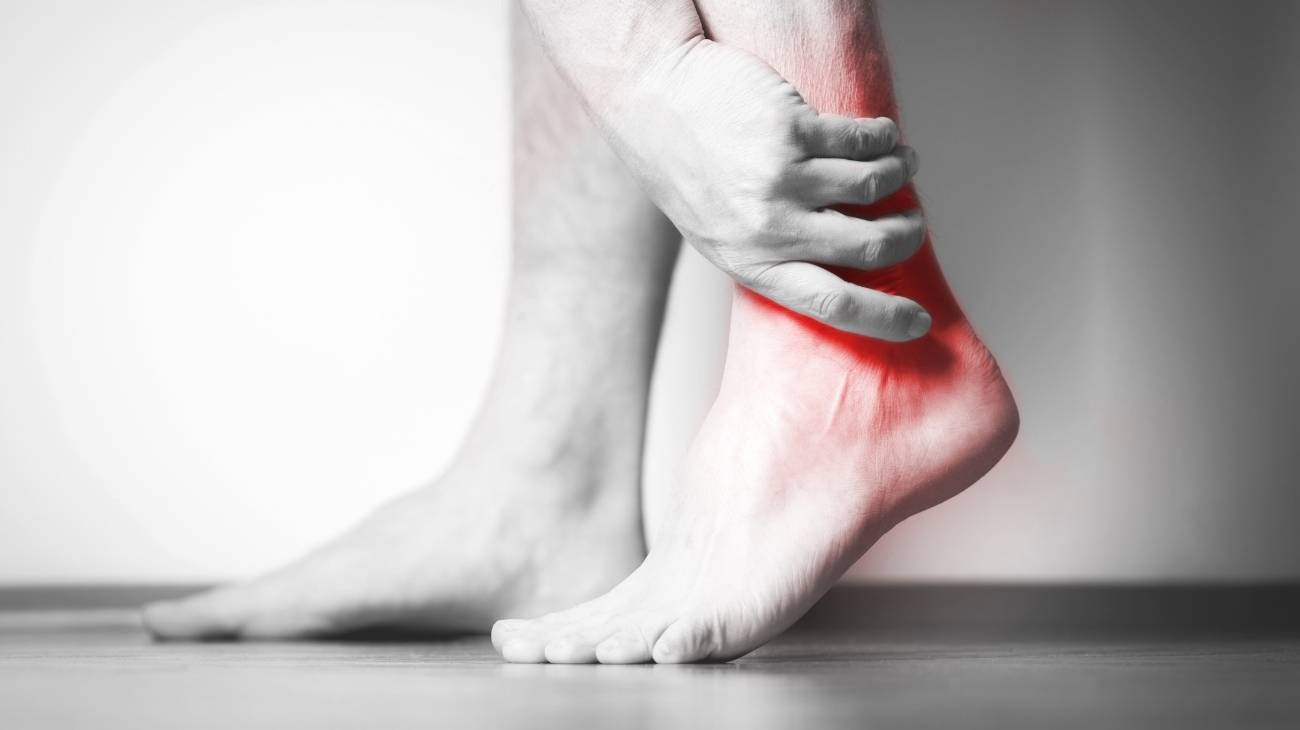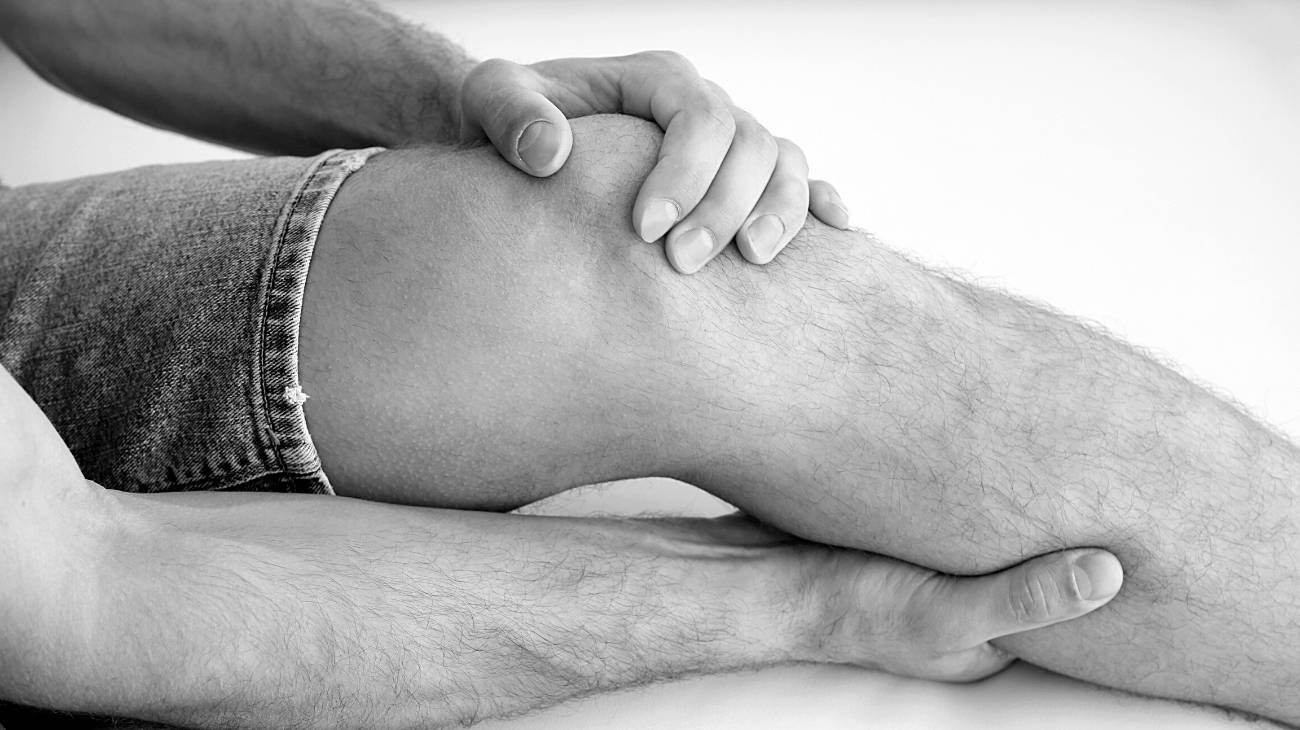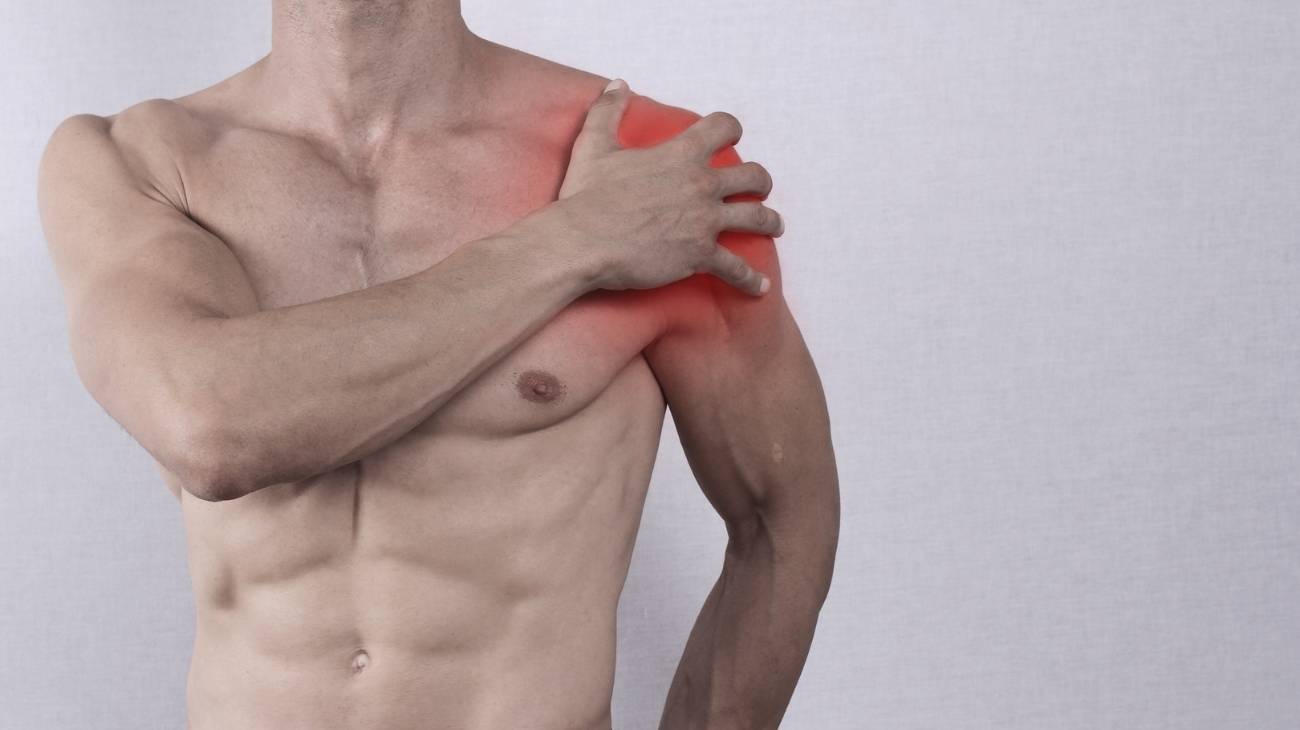- What is an elbow sprain and what degrees are there?
- What are the causes and risk factors for elbow sprains?
- Best products for elbow sprain
- Main symptoms that warn us that we have an elbow sprain
- What treatments are available to improve the symptoms of an elbow sprain?
- Which prevention methods for elbow sprains are the most effective?
Ligaments are bands of tissue that connect one bone to another, so when they are stretched more than normal, a rupture (partial or total) or distension occurs, which produces what we call a sprain. Thus, if the ligament affected is the one that connects the bones of the upper and lower arm, an elbow sprain is the result.
Depending on the severity of the case, there are different types of elbow sprains. Therefore, here we will let you know what they are, as well as their causes, symptoms, treatments and care methods to prevent this pathological condition.
What is an elbow sprain and what degrees are there?
A sprained elbow is a tear, stretch or strain of the ligamentous tissue that connects the humerus to the ulna and radius. That is, the ligaments that stabilise the elbow and have the function of keeping the joint together and unalterable.
This type of sprain usually occurs when the arm is twisted or bent rapidly in an abnormal posture that impairs its ability to make those movements. Likewise, if the ligaments are overstretched by loads greater than they can bear during normal movement, it is also possible that a sprain or injury of this kind may be caused.
However, by default, sprains that occur in the elbow of patients are categorised according to the severity of the injury. Therefore, when diagnosing such a condition, health professionals must determine what grade it is, according to the following:
Grade 1
This is the mildest case of elbow sprains. Basically, they produce a trivial strain of the ligaments and only trigger some micro-tearing of the ligamentous tissue. Consequently, there is no associated joint laxity or tissue tearing and as a result, pain is subdued, swelling is minimal and the individual has the ability to perform full movement of the arm area.
Grade 2
If the elbow sprain reaches grade II, it means that the ligaments are partially torn and therefore not completely ruptured. For this reason, the pain is moderate and can be controlled, the swelling is more pronounced than in the previous case, and there is moderate instability in the joint. Apart from that, the person may show deformity and ecchymosis (or bruising) in this part of the arm.
Grade 3
This is the highest level of severity that a sprained elbow can display, as it causes a complete rupture of the ligamentous portion, resulting in more intense pain, prominent swelling, great instability of the joint, as well as noticeable deformity and ecchymosis in the elbow. In addition, if left untreated, it can lead to chronic sprain and even more serious conditions over time.
What are the causes and risk factors for elbow sprains?
Beyond knowing that elbow sprains or strains are caused by abnormal stretching of the ligaments adjacent to this region of the arm, it is important to know what are the main movers, drivers or risk factors that contribute to this happening.
Below, we list the most relevant causes linked to the occurrence of such an elbow injury:
- If a person experiences a hard fall on an outstretched arm, an elbow sprain is often present.
- In the case of sudden movements that trigger overuse of the elbow, this injury can also be externalised.
- Blows and direct trauma to the elbow are another major cause of elbow ligament impingement.
- When the patient bends or twists the arm, this category of condition is likely to occur.
- During automobile accidents, victims can also get a sprained elbow.
- Athletes involved in gymnastics or basketball, for example, suffer this kind of sprain on numerous occasions.
- Another risk factor is imbalance and lack of coordination on the part of the patient.
- Decreased joint hypermobility, which is the main cause of loose joints, also leads to these injuries.
- If a person overexerts the arm muscles inappropriately, he or she is more likely to suffer an elbow sprain.
Best products for elbow sprain
Bestseller
-
2 Elbow Compression Sleeve (Black/Gray)
$19.95 -
2 Elbow Compression Sleeve (Green/Navy)
$19.95 -
2 Elbow Compression Sleeve (Pink/Bordeaux)
$19.95 -
2 Tennis Elbow Brace (Black/Gray)
$14.95 -
2 Tennis Elbow Brace (Green/Navy)
$14.95 -
2 Tennis Elbow Brace (Pink/Bordeaux)
$14.95 -
Acupressure Mat and Pillow (Black/Gray)
$49.95 -
Acupressure Mat and Pillow (Green/Navy)
$49.95 -
Acupressure Mat and Pillow (Pink/Bordeaux)
$49.95
Main symptoms that warn us that we have an elbow sprain
Whenever a patient suffers an elbow sprain, it naturally reveals its own symptoms that distinguish it from other similar conditions. This enables the health care professional to diagnose such an injury and even to define the degree of the injury.
The main signs and symptoms that usually indicate a sprain in the arm, which are:
- Pain and stiffness, which tends to increase with movement of the upper limb.
- Swelling, tenderness and discomfort around the affected elbow.
- A noticeable reduction in arm movement.
- Redness, bruising or changes in skin colour in the area.
- Perception of warmth in the elbow and/or adjacent areas.
- If the case becomes more severe, signs such as: numbness or coldness below the injury (in the hands or fingers, for example), pale or bluish skin on the impacted arm and increased pain (becomes unbearable) are triggered.
What treatments are available to improve the symptoms of an elbow sprain?
Many sprain sufferers assume that the only solution to relieve this condition is to use drugs to reduce pain and inflammation, as well as to eliminate the symptoms of the condition. However, there are other effective methods that operate as an optimal treatment to speed up the recovery process when a sprained elbow occurs.
Below, we mention what they are and how each of them is implemented:
Alternative and complementary therapies
Alternatively, various therapies have emerged that have shown good results in calming the symptoms of an elbow sprain, thanks to their analgesic, anti-inflammatory and sedative effect.
These complementary therapeutic techniques are described below:
- Heat and cold therapy: This is a procedure that uses the properties of heat and cold to improve the symptoms of a neck sprain. Taking into account that the combination of these temperatures in the form of therapy helps to reduce pain, reduce swelling and relax tense muscles in any part of the body. Thus, in this case, it is advisable to apply an ice pack for 15 to 20 minutes on the affected elbow and alternate it with moist heat (also in compresses) for the same amount of time. It is important to do this 3 or 4 times a day, for two or three consecutive days (depending on medical recommendations).
- Compression therapy: Compressive therapy is therapy that uses a device or elastic element to exert a controlled force on an area of the body where blood flow needs to be improved, reducing venous pressure and normalising the function of the vascular wall in order to reduce pain and inflammation. In the case of this kind of sprain, such therapy is applied with an elastic bandage or compression elbow brace that supports the elbow and keeps it snug but not too tight.
- Acupuncture therapy: Traditional Chinese medicine proposes this therapy to improve blood circulation, reduce inflammation of the impacted area and reduce pain caused by injuries. This is done by inserting fine needles in certain points of the skin to achieve a natural analgesic effect and spread it throughout the body. It should be noted that, in order to resort to this treatment during an elbow sprain, it is vital to request the services of a medical professional to perform the technique correctly, depending on the case.
- Thermotherapy: One of the best therapeutic treatments to treat different injuries in the body is thermotherapy, which stands out for using heat (or temperatures higher than that of the patient's body) with the aim of reducing swelling and soothing pain. For this, heat is applied in solid, gaseous or semi-liquid form for therapeutic purposes to the elbow to trigger a healing reaction to the sprain the person is suffering from. Never apply immediately after an injury, wait at least 72 hours.
- Natural remedies using plants: Inherent plant-based medicines are also ideal for minimising the pain caused by a sprain in the body. Therefore, to treat an elbow injury of this type, it is recommended to resort to certain plants with analgesic, anti-inflammatory and relaxing properties that accelerate the recovery process. In this case, it is suggested to: use arnica topically, take infusions of St. John's wort and horsetail, rub lavender essential oil, apply ginger or garlic compresses.
- Healthy lifestyle habits: In order to reduce the symptoms and signs of an elbow sprain, it is also essential to acquire certain healthy lifestyle habits that will help to avoid this pathology on subsequent occasions, as long as possible. Do exercises that gradually strengthen the muscles, eat a healthy and balanced diet, avoid a sedentary lifestyle and obesity, do not practice contact sports that you are unfamiliar with, and do appropriate stretching to support the elbow ligaments.
Nutritional supplements
A useful formula to alleviate this ailment caused in the elbow area, consists of combining some food supplements with balanced meals that allow the organism to guarantee an excellent functioning, in general.
In this way, it will be possible to ensure joint care and thus speed up the rehabilitation process required for an injury of this category. In addition, it is considered a good method to prevent the manifestation of this pathology.
We recommend taking the following vitamin-based food supplements:
- B complex: Some B vitamins, such as vitamin B1, B6 and B12 (thiamine, pyridoxine and cyanocobalamin, respectively) are essential to optimise the functionality of all areas of the body where the joints are located. They also have an analgesic effect and regulate the functioning of the nervous system. To consume it and avoid elbow sprains (omitting accidents), the ideal food sources are: liver, fish, meat, eggs, milk, whole grains, legumes, nuts, bananas, etc.
- Collagen: This is an effective protein for improving all musculoskeletal pathologies, as it is involved in ligaments, tendons, muscles and other tissues that contribute to the maintenance of joint mobility. It is therefore essential for treating this type of sprain because it reduces pain and increases mobility. For this reason, patients should avoid collagen deficiency by eating foods such as eggs, cheese, milk, meat, oily fish, avocado, onion, celery, cherries, strawberries, nuts, etc.
- Vitamin A: This is an antioxidant substance that influences the formation and maintenance of soft and bone tissue, strengthens the immune system and benefits different organs (heart, kidneys and lungs), making it crucial for the body to function properly. Consequently, it is also indicated to prevent the symptoms triggered by a sprained elbow, and you can get it from: carrots, papaya, mango, peaches, spinach, peppers, eggs, milk, cod liver oil, etc.
Physiotherapy treatments
At the physiotherapeutic level, there are different alternatives that allow a good elbow rehabilitation plan to be carried out when this type of injury occurs. This is a health science discipline that proposes therapies and exercises that help to reduce pain and inflammation, restore elbow strength and resistance, recover joint movements and avoid possible relapses or future injuries.
In this sense, a physiotherapy treatment to treat an elbow sprain provides faster healing, maximises mobility during your recovery regime, strengthens elbow function by restoring its power and reduces the chances of further elbow sprains significantly.
However, before resorting to this kind of treatment, it is best to have an expert assess your diagnosis and the extent of your injury to define the exact rehabilitation programme you need in conjunction with physiotherapy.
Physiotherapy offers to improve the symptoms triggered by a sprain in this part of the arm:
- Cryotherapy: This consists of a physiotherapeutic treatment that, by applying local cold to the injured region, produces analgesic and anti-inflammatory effects. It exerts a vasoconstrictor effect on the organism to destroy the tissue locally and in a controlled manner, causing the rupture of the cellular membrane for therapeutic purposes. Thus, if the sprain is in the acute phase, it is recommended to apply cold (with ice or a frozen reusable bag) every two hours for 10 to 15 minutes, for 1 to 7 days.
- Flexibility exercises: Basically, these are elbow stretching exercises that are designed to restore mobility to the elbow and, of course, optimise the flexibility of those muscles that cross the elbow. Depending on the case, they usually have to be performed three times a day (as long as they do not increase the pain excessively). Some of them are: elbow flexions and extensions, forearm rotation (pronation and supination) and biceps stretching.
- Strengthening exercises: These are practices that help improve the strength of the elbow muscles so that the elbow can rehabilitate and function as well (or better) than it did before the injury. If your physiotherapist recommends such exercises for you, it is essential that you start with the most basic exercises and, as your strength improves, advanced exercises can be added to the programme. In general, the most common are: triceps isometrics, biceps isometrics, pronation and supination with resistance band, biceps curl with resistance band, resisted triceps extension in the chair, etc.
Medications
In most cases, patients with a sprained elbow, in addition to the complementary therapies mentioned above, opt to use over-the-counter drugs to help relieve the pain, reduce swelling and improve all the symptoms of such an injury.
However, it is not advisable to self-medicate because the side effects can be truly dangerous (they tend to cause diarrhoea, nausea, dizziness, fainting, drowsiness, fatigue, addiction and even cardiac arrest).
Therefore, if you have suffered from such a condition and you notice that self-care is not helping the rehabilitation process, there is increased pain and/or swelling, and even noticeable instability in your elbow, it is best to visit a medical specialist who can treat your case more closely and get a clear and concise diagnosis.
Under this, taking into account your medical history, your state of health, your tolerance to medication, the severity of the injury, your age and other details, he or she will prescribe the most appropriate drugs to normalise the functioning of your elbow.
Surgery
Medically, it is not considered necessary to perform a surgical procedure to repair an elbow sprain. However, in some cases when an elbow sprain is at its most severe, patients must undergo surgery to repair the torn ligament. This means that if all non-surgical methods available have been used and the affected ligament tissue still has not healed, surgery is a must.
Which prevention methods for elbow sprains are the most effective?
Elbow sprains are usually caused by accidents and therefore cannot be prevented in these circumstances. However, it is a condition that also has other causes over and above which it is possible to consider certain prevention methods to avoid suffering such an injury.
We will let you know how to effectively avoid spraining or straining your elbow as far as possible:
- Warm-up: It is essential to warm up before any sport. Therefore, don't forget to stretch properly before exercising to avoid sprains.
- Physical activity: Do physical activities constantly and gradually. This will help you strengthen your arm muscles and prevent sprains caused by a sedentary lifestyle.
- Overweight: Obesity is one of the risk factors for this type of injury. Therefore, it is important to maintain an appropriate body weight to reduce the chances of suffering an elbow sprain.
- Healthy diet: To prevent obesity and, at the same time, strengthen your body in general, it pays to have a healthy and balanced diet. This, together with the recommended dietary supplements, will give your body the ability to hinder these elbow injuries.
- Low-impact sports: Don't engage in extreme and/or unfamiliar sports. In this way, you will avoid suffering heavy falls or resisting injuries due to wrongly performed movements.
- Do not lift excessive weights: It is also advisable to avoid carrying heavy items and/or overexerting your arms, which can usually lead to a sprain in this region of the limb.
- Compression clothing: Another effective method to prevent this condition is to use the correct equipment to protect the elbow when doing sports, such as, for example, a compression elbow brace, which is a piece of fabric that is placed around the elbow to protect it against knocks and chafing.
- Rest: If you are tired or feel any discomfort in your arm or elbow before exercising, the most appropriate thing to do is not to do it. This is another risk factor for accidents and, as a consequence, sprains.
References
- Kenter, K., Behr, C. T., Warren, R. F., O'Brien, S. J., & Barnes, R. (2000). Acute elbow injuries in the National Football League. Journal of shoulder and elbow surgery, 9(1), 1-5. https://www.sciencedirect.com/science/article/abs/pii/S1058274600800233
- Chamseddine, A., Zein, H., Obeid, B., Khodari, F., & Saleh, A. (2011). Posterolateral rotatory instability of the elbow secondary to sprain. Chirurgie de la Main, 30(1), 52-55. https://europepmc.org/article/med/21334955
- Andrews, J. R., & Whiteside, J. A. (1993). Common elbow problems in the athlete. Journal of Orthopaedic & Sports Physical Therapy, 17(6), 289-295. https://www.jospt.org/doi/abs/10.2519/jospt.1993.17.6.289
- Savoie, F. H., & O’Brien, M. (2020). Sprains, strains, and partial tears of the medial ulnar collateral ligament of the elbow. Clinics in Sports Medicine, 39(3), 565-574. https://www.sportsmed.theclinics.com/article/S0278-5919(20)30020-X/fulltext
- Thornton, R., Riley, G. M., & Steinbach, L. S. (2003). Magnetic resonance imaging of sports injuries of the elbow. Topics in Magnetic Resonance Imaging, 14(1), 69-86. https://journals.lww.com/topicsinmri/Fulltext/2003/02000/Magnetic_Resonance_Imaging_of_Sports_Injuries_of.6.aspx
- Nitz, A. J., Dobner, J. J., & Kersey, D. (1985). Nerve injury and grades II and III ankle sprains. The American journal of sports medicine, 13(3), 177-182. https://journals.sagepub.com/doi/abs/10.1177/036354658501300306
- Derscheid, G. L., & Garrick, J. G. (1981). Medial collateral ligament injuries in football: nonoperative management of grade I and grade II sprains. The American Journal of Sports Medicine, 9(6), 365-368. https://journals.sagepub.com/doi/abs/10.1177/036354658100900605
- Thompson, C., Kelsberg, G., & St Anna, L. (2003). Heat or ice for acute ankle sprain?. https://mospace.umsystem.edu/xmlui/handle/10355/2939
- Nunley, J. A., & Vertullo, C. J. (2002). Classification, investigation, and management of midfoot sprains: Lisfranc injuries in the athlete. The American journal of sports medicine, 30(6), 871-878. https://journals.sagepub.com/doi/abs/10.1177/03635465020300061901
- Roach, C. J., Haley, C. A., Cameron, K. L., Pallis, M., Svoboda, S. J., & Owens, B. D. (2014). The epidemiology of medial collateral ligament sprains in young athletes. The American journal of sports medicine, 42(5), 1103-1109. https://journals.sagepub.com/doi/abs/10.1177/0363546514524524







